Introduction
A friend recently asked me a question related to evangelism. How can we determine that someone has believed the saving message when we present the message of eternal life?
In many cases when churches or missionaries give a gospel presentation, there is a desire to confirm that people were saved. Because of this desire, many popular traditions have developed. The pastor might ask the new converts to raise their hands or to walk the aisle in order to prove they “really” believed. Another common method is to have the evangelist lead the person in a “sinner’s prayer.” Missionaries will return from their trips claiming that hundreds of thousands “came to faith” during their time overseas. When you ask them how they determined these numbers, many will reply that they baptized the new believers. Similar acts of proof permeate churches all over the world. These are often done as a way to “seal the deal” after sharing the saving message. The evangelist can’t look at someone and know whether they have believed, so many seek and are trained to add these additional steps.
The problem with all these examples is that they point to an external action as proof or validation of salvation. However, unbelievers are not saved because they raised a hand or walked an aisle or took any additional step. The unbeliever is saved when he believes in Jesus for the gift of eternal life (John 1:12; 3:16; 5:24; 6:40, 47). Sadly, when evangelists insert these arbitrary steps, confusion follows. The insertion of these follow-up steps leads many to think the steps were necessary for salvation. This nullifies the message of eternal life as a free gift (Eph 2:8-9; John 4:10,14).
Another significant issue with these additional actions is that they are not found in the Bible. When we consider the Gospel of John, the only evangelistic book in the Bible (John 20:30-31), none of these subjective add-ons are present. Some writers have noted that the closest thing to an “invitation” by the Lord is found in John 11:25-26.
The Lord is speaking to Martha and shares the saving message with her, saying:
“I am the resurrection and the life. He who believes in Me, though he may die, he shall live. And whoever lives and believes in Me shall never die. Do you believe this?”
After stating the saving message, the Lord asks if she believes it. The Lord doesn’t demand some act of obedience from Martha in order to prove that she believed. He doesn’t ask her to raise her hand, get baptized, or walk an aisle. The Lord simply asks Martha if she has believed the message He just shared. His example is the one we should follow. When sharing the message of eternal life, any follow-up conversation should be centered on confirming that the person has been convinced of the saving message, rather than on some action.
My friend’s question speaks to the desire of many to make sure they were clear when sharing the saving message. Sometimes we evangelize and think that we were clear, but later find out that the person was still confused. We can explain John 3:16 or Eph 2:8-9, but the unbeliever could still walk away thinking they can lose their salvation. What can we say or ask after sharing the message of life to make sure that we were understood? I would like to make a suggestion.
First, follow the Lord’s example. Ask them if they believed what the Lord has promised in these passages. Ask them if they have believed in Jesus for eternal life, and that they understand that this life can never be lost.
Second, if they say that yes, they have believed in Jesus for eternal life, ask them an “even if” question.
Give a few examples:
Do you still have eternal life even if you stop going to church?
Do you still have eternal life even if you lie or commit adultery?
Do you still have eternal life even if “fill in the blank”.
This method does two things. It removes any confusion regarding an additional action. You aren’t adding or looking for external proof via a work such as a prayer or raising their hand. Second, it gives the evangelist an insight into what the person believes. If they have believed in Jesus for eternal life and have understood that this life can never be lost, than the answer will always be “yes.” Even if they fall into sin, they still have eternal life, because eternal life can never be lost. If they have believed the message, they will be confident in saying “yes.” I have personally had people start adding to my examples of “even if” statements. The goal is that they have assurance of salvation, even if they fail later. However, if they are still confused, they often will waiver in their answers, or say “no” to some of the “even if” examples. In that case, I would encourage the evangelist to return to the saving message and the promise of eternal life as a gift that can never be lost.
In 2 Tim 2:13, the Apostle Paul makes this amazing statement about our Savior and His faithfulness:
“If we are faithless,
He remains faithful;
He cannot deny Himself.”
In other words, the apostle gives an “even if” statement. Even if we are faithless, the Lord remains faithful. He has promised that those who have believed in Him shall never perish, but shall have eternal life (John 3:16, 5:24, 6:40, 47, 11:26-27). Even if we fail, His promise is forever. Do you believe that?

